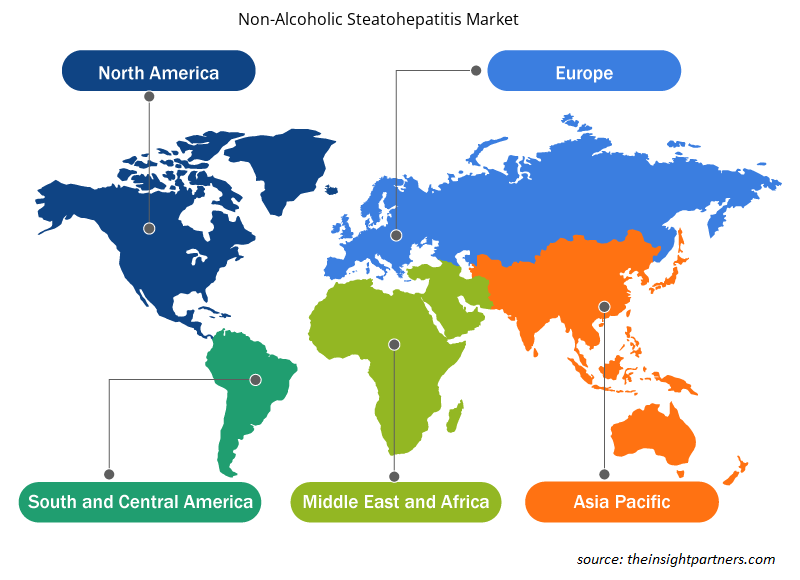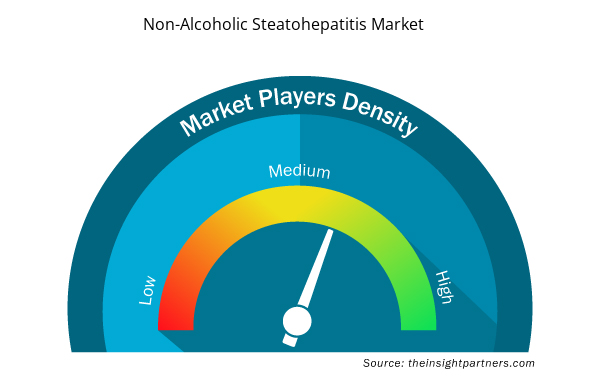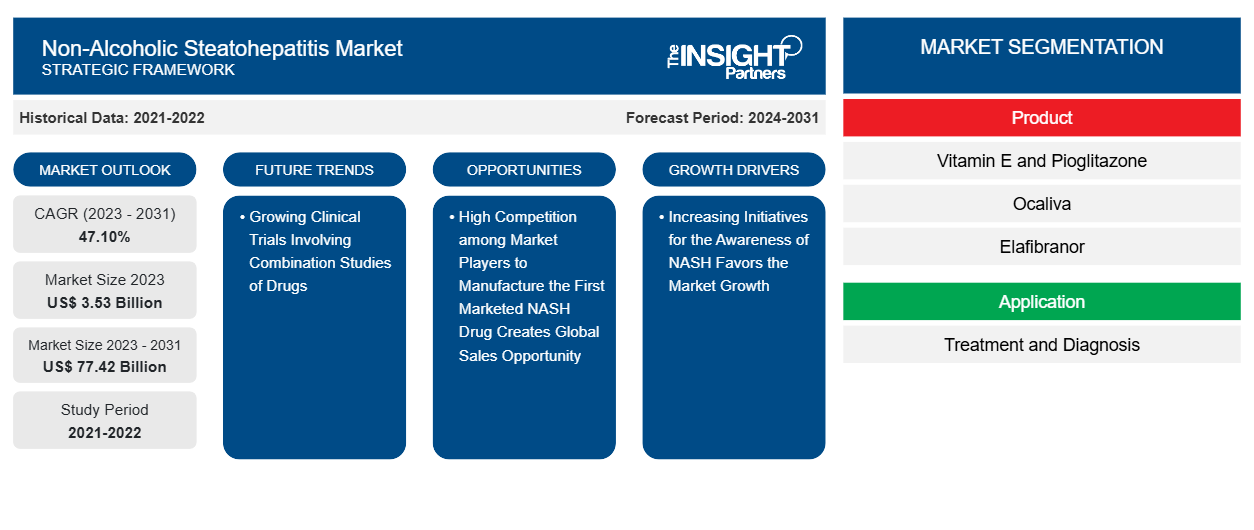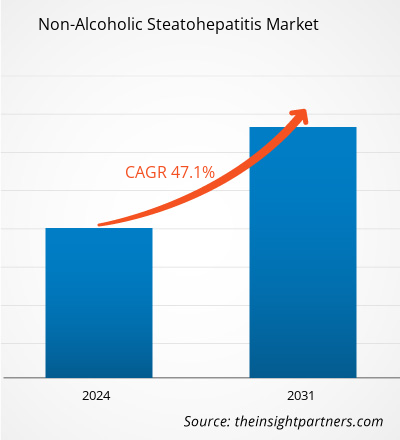非酒精性脂肪性肝炎市场规模预计将从 2023 年的 35.3 亿美元增至 2031 年的 774.2 亿美元。预计 2023-2031 年期间市场复合年增长率将达到 47.10%。涉及药物联合研究的临床试验不断增加可能仍将是市场的主要趋势。
非酒精性脂肪性肝炎市场分析
NASH 疾病发病率的上升预计将推动 NASH 治疗市场实现更显著的增长。推动市场增长的主要因素是生物技术行业的扩张和该领域研发支出的增加。不久的将来,由于 NASH 诊断的采用率不断提高,将会出现大量有利可图的机会,预计亚太地区的增长速度最快。企业已经实施了多项举措,包括无机和有机举措,以支持其扩张。公司一直在使用各种有机策略来扩展业务,例如产品发布。企业已经使用了合作、合并和收购等无机策略。例如,Intercept Pharmaceuticals, Inc.于 2021 年 7 月宣布,将在第 56 届欧洲肝脏研究协会 (EASL) 年会上发表几篇关于使用奥贝胆酸 (OCA) 治疗原发性胆汁性胆管炎 (PBC) 和非酒精性脂肪性肝炎 (NASH) 的摘要,该年会将于 2021 年 6 月 23 日至 6 月 26 日以线上方式举行。
非酒精性脂肪性肝炎市场概览
非酒精性脂肪性肝炎(NASH)是一种潜在致命疾病,会导致严重的肝硬化和瘢痕形成。世界上最常见的慢性肝病是非酒精性脂肪性肝病(NAFLD)。一种称为 NASH 的进行性 NAFLD 类型在终末期肝病和肝移植中日益占据主导地位。全球肝病研究所于 2019 年 6 月 12 日发布的数据表明,非酒精性脂肪性肝炎(NASH)被视为一种流行病。此外,它是一种随时间推移而进展的非酒精性脂肪性肝病(NAFLD),目前影响约 1.15 亿人,预计到 2030 年将影响 3.57 亿人。NAFLD 和 NASH 的重要风险因素包括肥胖、2 型糖尿病和高脂血症;超过 70% 的人口肥胖,75% 患有 2 型糖尿病,20-80% 患有高脂血症。如果不治疗 NASH,它会导致肝癌、肝硬化,甚至需要肝移植。
NAFLD/NASH 越来越常见,但它仍然是一种未被充分诊断的疾病,需要及早发现才能防止其发展和随之而来的后果。因此,预计 NASH 患病率的上升将推动非酒精性脂肪性肝炎 (NASH) 市场的发展。
定制此报告以满足您的需求
您可以免费定制任何报告,包括本报告的部分内容、国家级分析、Excel 数据包,以及为初创企业和大学提供优惠和折扣
- 获取此报告的关键市场趋势。这个免费样品将包括数据分析,从市场趋势到估计和预测。
非酒精性脂肪性肝炎市场驱动因素和机遇
提高对 NASH 的认识有利于市场增长
NASH 是一种尚未得到充分了解的疾病。系统性转诊途径和早期发现该疾病取决于提高公众和初级保健医生 (PCP) 对该疾病的认识。通过创建明确的患者转诊途径和患者意识活动,可以识别更多患者并将他们送往专家处进行额外评估,从而增加患者数量。2018 年 6 月 12 日是“国际 NASH 日”,NASH 教育计划发起了一项公共教育活动,以提高公众对非酒精性脂肪性肝病 (NAFLD) 及其更高级形式 NASH 的了解,NAFLD 影响超过 1.15 亿人。
2019 年 6 月 12 日是国际 NASH 日,致力于提高 NASH 流行病曝光度和认知度的数字平台 NASH 24X7 采取了一些行动,包括 HCP 支持患者认知度。NASH 24X7 的 NASH Crusaders 与印度各地的领先 HCP(胃肠病学家和肝病学家)合作,在国际 NASH 日传播认知度。在患者教育方面,NASH 24X7 的 NASH Crusaders 与印度各地的医疗保健专业人员合作,组织了许多小型和大型认知和教育研讨会,主题是肝脏健康以及健康生活方式对预防 NAFLD/NASH 的重要性。在国际 NASH 日,发起了多项举措来接触公众,包括使用印刷和数字媒体的新闻稿和电视节目。
2020 年 6 月 12 日是国际 NASH 日,在 Allergan 基金会的支持下,美国肝病基金会加入了一个全球社区,以提高人们对 NASH 的认识。美国肝病基金会 (ALF) 目前正在试行 NASH 短信计划,人们可以注册接收为期十周的每周三条消息。消息包括指向 NASH 资源、事实、互动测验和日常自我管理的合理指示的超链接。试点完成并评估后,ALF 将向公众开放该系统。它与全球肝病研究所 (GLI) 合作举办国际 NASH 日活动,并分享了一些社交媒体帖子,其中包含指向 GLI 帖子和国际 NASH 日页面的链接。
因此,提高对 NASH 的认识的举措不断增多,正在推动非酒精性脂肪性肝炎 (NASH) 市场的发展。steatohepatitis (NASH) market.
市场参与者为生产首款上市的 NASH 药物而展开的激烈竞争创造了全球销售机会
根据 Back Bay Life Science Advisors 的数据,预计到 2030 年,全球 NASH 市场规模将达到顶峰,平均每年 130 亿美元。截至 2020 年 6 月,NASH 第一波药物管线中有 47 家公司正在开发 54 种候选药物,正在评估 29 种独特的作用机制。在过去的几十年中,NASH 管线见证了许多后期项目在关注多种作用机制后未能揭示临床疗效。市场参与者对生产首个上市 NASH 药物的竞争仍然很激烈,许多后期候选药物都在争夺推出首个上市 NASH 药物的机会。以下是一些处于药物开发第 3 阶段和第 2 阶段的公司。市场参与者竞相成为第一个将药物推向市场的公司,从而为在全球市场上创造更大的销售机会。
非酒精性脂肪性肝炎市场报告细分分析
有助于得出非酒精性脂肪性肝炎市场分析的关键部分是产品、应用和销售渠道。
- 根据产品,非酒精性脂肪性肝炎市场细分为维生素 E 和吡格列酮、elafibranor、ocaliva、selonsertib 和 cenicriviroc 等。其他细分市场在 2023 年占据了最大的市场份额。
- 根据应用,市场分为治疗和诊断。治疗领域在 2023 年占据了最大的市场份额。
- 根据销售渠道,市场分为医院药房、在线供应商和零售药房。零售药房在 2023 年占据了最大的市场份额。
非酒精性脂肪性肝炎市场份额(按地区)分析
非酒精性脂肪性肝炎市场报告的地理范围主要分为五个地区:北美、亚太、欧洲、中东和非洲、南美和中美。
北美由三个国家组成:美国、加拿大和墨西哥。美国是非酒精性脂肪性肝炎的最大市场,其次是加拿大和墨西哥。由于研发活动的增加以及技术进步的采用增加,非酒精性脂肪性肝炎市场预计将以更快的速度增长。大型医疗保健组织和非酒精性脂肪性肝炎的患病率上升也推动了该领域的市场增长。超重脂肪在肝脏中堆积,这种情况称为非酒精性脂肪性肝病 (NAFLD)。大量饮酒并不是造成这种脂肪堆积的原因。酒精性肝病是指因大量饮酒导致肝脏脂肪堆积的一种疾病。非酒精性脂肪肝 (NAFL) 和非酒精性脂肪性肝炎 (NASH) 是 NAFLD 的两种形式。在美国,NAFLD 是肝病最常见的原因之一。大多数 NAFLD 患者都患有 NAFL。NASH 仅占 NAFLD 患者的一小部分。据专家介绍,1.5% 至 6.5% 的美国成年人患有 NASH,约 24% 的美国成年人患有 NAFLD。
NASH 的特征是脂肪堆积、炎症和细胞损伤;它还可能导致肝硬化和肝细胞癌。根据美国一项患病率研究,2016 年美国有 1730 万例 NASH 病例和 8530 万例 NAFLD 病例。由于这些情况,美国医疗费用高达数十亿美元。此外,NAFLD 本身就是心血管疾病的风险因素。因此,NAFLD 和 NASH 正成为支付方需要监控的越来越重要的疾病状态。
非酒精性脂肪性肝炎市场区域洞察
Insight Partners 的分析师已详细解释了预测期内影响非酒精性脂肪性肝炎市场的区域趋势和因素。本节还讨论了非酒精性脂肪性肝炎市场在北美、欧洲、亚太地区、中东和非洲以及南美和中美洲的细分市场和地理位置。

- 获取非酒精性脂肪性肝炎市场的区域特定数据
非酒精性脂肪性肝炎市场报告范围
| 报告属性 | 细节 |
|---|---|
| 2023 年的市场规模 | 35.3亿美元 |
| 2031 年市场规模 | 774.2亿美元 |
| 全球复合年增长率(2023 - 2031) | 47.10% |
| 史料 | 2021-2022 |
| 预测期 | 2024-2031 |
| 涵盖的领域 | 按产品
|
| 覆盖地区和国家 | 北美
|
| 市场领导者和主要公司简介 |
|
非酒精性脂肪性肝炎市场参与者密度:了解其对业务动态的影响
非酒精性脂肪性肝炎市场正在快速增长,这得益于终端用户需求的不断增长,而这些需求又源于消费者偏好的不断变化、技术进步以及对产品优势的认识不断提高等因素。随着需求的增加,企业正在扩大其产品范围,进行创新以满足消费者的需求,并利用新兴趋势,从而进一步推动市场增长。
市场参与者密度是指在特定市场或行业内运营的企业或公司的分布情况。它表明在给定市场空间中,相对于其规模或总市场价值,有多少竞争对手(市场参与者)存在。
在非酒精性脂肪性肝炎市场运营的主要公司有:
- 瑞士金菲特公司
- 单向肝脏,SL
- 生物预测 SAS
- 卡迪拉制药有限公司
- 普罗米修斯实验室
- 西门子医疗股份公司
免责声明:上面列出的公司没有按照任何特定顺序排列。

- 获取非酒精性脂肪性肝炎市场顶级关键参与者概述
非酒精性脂肪性肝炎市场新闻和最新发展
通过收集一级和二级研究后的定性和定量数据来评估非酒精性脂肪性肝炎市场,其中包括重要的公司出版物、协会数据和数据库。以下列出了非酒精性脂肪性肝炎市场的一些发展情况:
- 诺华宣布已与 Carisma Therapeutic 签署协议,生产 HER 2 靶向 CAR-M 细胞疗法,该疗法在治疗实体肿瘤的初步试验中进行了测试。(来源:诺华股份公司,新闻稿,2022 年 3 月)
- 西门子医疗宣布在美国推出增强型肝纤维化 (ELF) 检测。这是该检测首次在美国上市,此前该检测于 2021 年 8 月获得美国食品药品管理局 (FDA) 的 De Novo 营销授权。(来源:西门子医疗股份公司,新闻稿,2022 年 1 月)
非酒精性脂肪性肝炎市场报告覆盖范围和交付成果
“非酒精性脂肪性肝炎市场规模和预测(2021-2031 年)”报告对以下领域进行了详细的市场分析:
- 范围内涵盖的所有主要细分市场的全球、区域和国家层面的非酒精性脂肪性肝炎市场规模和预测
- 非酒精性脂肪性肝炎市场趋势以及市场动态,如驱动因素、限制因素和关键机遇
- 详细的 PEST/波特五力分析和 SWOT 分析
- 非酒精性脂肪性肝炎市场分析涵盖主要市场趋势、全球和区域框架、主要参与者、法规和最新的市场发展。
- 行业格局和竞争分析,涵盖市场集中度、热图分析、知名参与者以及非酒精性脂肪性肝炎市场的最新发展
- 详细的公司简介
- 历史分析(2 年)、基准年、预测(7 年)及复合年增长率
- PEST 和 SWOT 分析
- 市场规模价值/数量 - 全球、区域、国家
- 行业和竞争格局
- Excel 数据集



Report Coverage
Revenue forecast, Company Analysis, Industry landscape, Growth factors, and Trends

Segment Covered
This text is related
to segments covered.

Regional Scope
North America, Europe, Asia Pacific, Middle East & Africa, South & Central America

Country Scope
This text is related
to country scope.
常见问题
The market is expected to register a CAGR of 47.1% during 2023–2031.
Genfit SA, Cadila Pharmaceuticals Ltd., One Way Liver, S.L., BioPredictive S.A.S., Siemens Healthineers AG, Intercept Pharmaceuticals, Inc., Prometheus Laboratories, Novartis AG, Galmed Pharmaceuticals, Laboratory Corporation of America Holdings
Key factors driving the market are the Rising Prevalence of NASH and Increasing Initiatives for the Awareness of NASH.
Growing clinical trials involving combination studies of drugs will likely remain a key trend in the market.
North America dominated the non-alcoholic steatohepatitis market in 2023
Trends and growth analysis reports related to Life Sciences : READ MORE..
The Insight Partners performs research in 4 major stages: Data Collection & Secondary Research, Primary Research, Data Analysis and Data Triangulation & Final Review.
- Data Collection and Secondary Research:
As a market research and consulting firm operating from a decade, we have published and advised several client across the globe. First step for any study will start with an assessment of currently available data and insights from existing reports. Further, historical and current market information is collected from Investor Presentations, Annual Reports, SEC Filings, etc., and other information related to company’s performance and market positioning are gathered from Paid Databases (Factiva, Hoovers, and Reuters) and various other publications available in public domain.
Several associations trade associates, technical forums, institutes, societies and organization are accessed to gain technical as well as market related insights through their publications such as research papers, blogs and press releases related to the studies are referred to get cues about the market. Further, white papers, journals, magazines, and other news articles published in last 3 years are scrutinized and analyzed to understand the current market trends.
- Primary Research:
The primarily interview analysis comprise of data obtained from industry participants interview and answers to survey questions gathered by in-house primary team.
For primary research, interviews are conducted with industry experts/CEOs/Marketing Managers/VPs/Subject Matter Experts from both demand and supply side to get a 360-degree view of the market. The primary team conducts several interviews based on the complexity of the markets to understand the various market trends and dynamics which makes research more credible and precise.
A typical research interview fulfils the following functions:
- Provides first-hand information on the market size, market trends, growth trends, competitive landscape, and outlook
- Validates and strengthens in-house secondary research findings
- Develops the analysis team’s expertise and market understanding
Primary research involves email interactions and telephone interviews for each market, category, segment, and sub-segment across geographies. The participants who typically take part in such a process include, but are not limited to:
- Industry participants: VPs, business development managers, market intelligence managers and national sales managers
- Outside experts: Valuation experts, research analysts and key opinion leaders specializing in the electronics and semiconductor industry.
Below is the breakup of our primary respondents by company, designation, and region:

Once we receive the confirmation from primary research sources or primary respondents, we finalize the base year market estimation and forecast the data as per the macroeconomic and microeconomic factors assessed during data collection.
- Data Analysis:
Once data is validated through both secondary as well as primary respondents, we finalize the market estimations by hypothesis formulation and factor analysis at regional and country level.
- Macro-Economic Factor Analysis:
We analyse macroeconomic indicators such the gross domestic product (GDP), increase in the demand for goods and services across industries, technological advancement, regional economic growth, governmental policies, the influence of COVID-19, PEST analysis, and other aspects. This analysis aids in setting benchmarks for various nations/regions and approximating market splits. Additionally, the general trend of the aforementioned components aid in determining the market's development possibilities.
- Country Level Data:
Various factors that are especially aligned to the country are taken into account to determine the market size for a certain area and country, including the presence of vendors, such as headquarters and offices, the country's GDP, demand patterns, and industry growth. To comprehend the market dynamics for the nation, a number of growth variables, inhibitors, application areas, and current market trends are researched. The aforementioned elements aid in determining the country's overall market's growth potential.
- Company Profile:
The “Table of Contents” is formulated by listing and analyzing more than 25 - 30 companies operating in the market ecosystem across geographies. However, we profile only 10 companies as a standard practice in our syndicate reports. These 10 companies comprise leading, emerging, and regional players. Nonetheless, our analysis is not restricted to the 10 listed companies, we also analyze other companies present in the market to develop a holistic view and understand the prevailing trends. The “Company Profiles” section in the report covers key facts, business description, products & services, financial information, SWOT analysis, and key developments. The financial information presented is extracted from the annual reports and official documents of the publicly listed companies. Upon collecting the information for the sections of respective companies, we verify them via various primary sources and then compile the data in respective company profiles. The company level information helps us in deriving the base number as well as in forecasting the market size.
- Developing Base Number:
Aggregation of sales statistics (2020-2022) and macro-economic factor, and other secondary and primary research insights are utilized to arrive at base number and related market shares for 2022. The data gaps are identified in this step and relevant market data is analyzed, collected from paid primary interviews or databases. On finalizing the base year market size, forecasts are developed on the basis of macro-economic, industry and market growth factors and company level analysis.
- Data Triangulation and Final Review:
The market findings and base year market size calculations are validated from supply as well as demand side. Demand side validations are based on macro-economic factor analysis and benchmarks for respective regions and countries. In case of supply side validations, revenues of major companies are estimated (in case not available) based on industry benchmark, approximate number of employees, product portfolio, and primary interviews revenues are gathered. Further revenue from target product/service segment is assessed to avoid overshooting of market statistics. In case of heavy deviations between supply and demand side values, all thes steps are repeated to achieve synchronization.
We follow an iterative model, wherein we share our research findings with Subject Matter Experts (SME’s) and Key Opinion Leaders (KOLs) until consensus view of the market is not formulated – this model negates any drastic deviation in the opinions of experts. Only validated and universally acceptable research findings are quoted in our reports.
We have important check points that we use to validate our research findings – which we call – data triangulation, where we validate the information, we generate from secondary sources with primary interviews and then we re-validate with our internal data bases and Subject matter experts. This comprehensive model enables us to deliver high quality, reliable data in shortest possible time.


 获取此报告的免费样本
获取此报告的免费样本